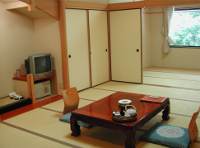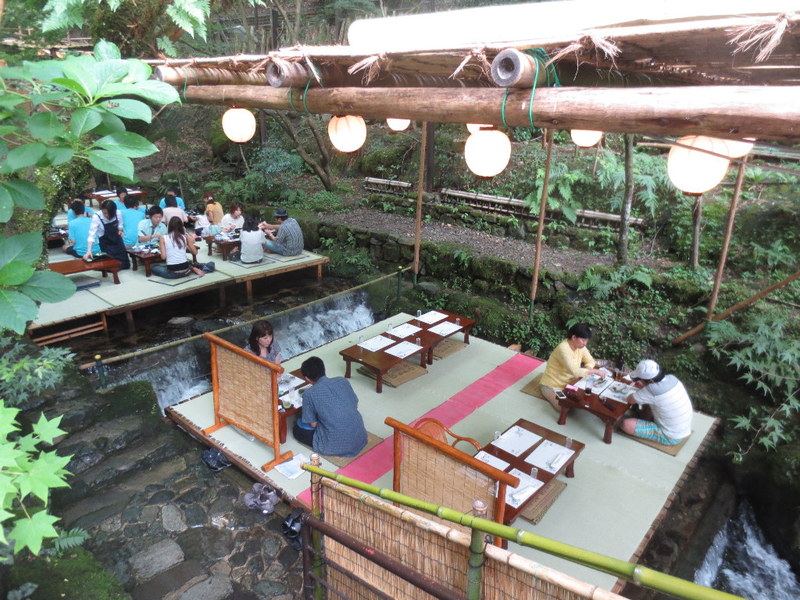Kurama and Kibune, Kyoto
Kurama and Kibune are two small villages in the woods in the mountains north of the city of Kyoto, respectively on Mount Kurama and Mount Kibune.
I have placed them in the same page because they are usually visited together, because of their proximity.
The typical itinerary is to arrive in one of the two villages, and then reach the other one through a long path (about 2 hours walk) in the woods. So you can decide to start your hike from Kurama, or Kibune.
If you visit the area during a cold period, a good idea might be to start from Kibune, and then arrive very tired in Kurama and relax in the warm waters of the
Kurama Onsen.
Kurama-Kibune hiking trail
Kurama and Kibune are connected by a path that crosses the woods and the mountains and passing by the temple Kurama-dera (see below).
The part of the trail between Kibune and Kurama-dera is the steepest and it takes about an hour and a half up to the temple, from Kurama-dera to the village of Kurama the path is easier and often covered by stairs, it takes half an hour or a little more to cover the whole path, and it is also much more popular.A portion of this route is also covered by a short funicular (see section about Kurama-dera).
Along the hiking trail you will encounter several small Buddhist or Shinto buildings, and be surrounded by majestic pine trees, wisteria, cedars.
Kurama
Kurama is a mountain village famous for its thermal springs and the nearby temple Kurama-dera, it is also a destination for many lovers of trekking and hiking.
Kurama Onsen
This place is actually a
ryokan where you can sleep too (see paragraph below), is located about 10 minutes walk from the station, and there is also a free shuttle service.
The property has two large bathtubs, one indoor and one outdoor. Even if not staying there, you can still access the onsen for a few hours, paying ¥ 1100 to use only the outdoor bath, or ¥ 2,500 for both, including the Jacuzzi and sauna.
To bathe in this onsen you must follow all the rules of traditional Japanese bathing, so you can only get into the water naked (of course baths are divided by sex), and only after you have washed well.
In winter, a bath in the outdoor hot tub, surrounded by woods, maybe covered with snow, is an
unforgettable experience.
Kurama-dera
(admission 200 yen, opening hours 9-16:30)
A Buddhist temple in the woods of Mount Kurama, in the middle of a trail that connects the villages of Kurama and Kibune.
It is said that the samurai
Minamoto no Yoshitsune was trained on this mountain by the legendary creature
Sojobo, king of
Tengu, born in this mountain according to the legend.
Much more realistic is instead the story according to which it was here that the Buddhist monk
Mikao Usui, developed the holistic healing technique called
Reiki in the early '900.
From the village of Kurama, you can reach this temple by walking through the forest for about half an hour, through a long stairway, or take a short funicular managed by the temple (
Kurama-dera Cable) with an offer of 100 yen which takes you up to about half way.
The walk is very pleasant for hikers and not, in fact, along the way you will often come across small minor temples and other typical Buddhist buildings.
Yuki-jinja Shrine
(free admission)
A Shinto shrine located along the path to the Kurama temple, known primarily for the
Kurama Fire Festival, one of the most important festivals of Kyoto that takes place every year on October 22.
The buildings of this shrine has a very particular style, definitely worth a short visit if you're on the way to the Kurama-dera.
Kibune
Kibune is a village with a few houses which extend in length along a road that runs next to a river.
There are some luxury ryokan, Kibune is in fact very much appreciated by the Japanese to relax a few days, especially during the summer months when the weather here is a bit 'cooler than in Kyoto.
During the summer months some particular restaurants open along the river (see below).
For the rest, there is not much to do, the Kibune Shrine is the only noteworthy building in the area.
Kibune shrine
(free admission, opening hours 6-20 may-nov, 6-18 dec-apr)
You get to this Shinto shrine after climbing a charming staircase surrounded by red lanterns.
Once there, after a few minutes to take some pictures you can go, there is not much to see.
 the staircase leading to the Kibune Shrine
the staircase leading to the Kibune Shrine
Sleeping, where to stay in Kurama and Kibune, recommended ryokans
Kurama and Kibune are places where you can have the experience of staying in a real Japanese ryokan. Like all true Japanese ryokan, the prices are very high, similar to those of 5-star hotels. Remember: if a ryokan is very cheap, it is certainly not a real ryokan.
Ryokans in Kurama
In Kurama there is only one ryokan. If by chance you would like to stay overnight on the evening of Kurama Fire Festival (October 22), you must know that you have to book at least 6 months in advance if you want to have any hope of finding a free room.
 Kurama Onsen
The only ryokan in the village, you can also take advantage of its onsen for a few hours of the day without stay overnight (see above), of course the onsen is available to guests at no extra charge. If you want to stay here, the service is without a doubt excellent and the location lovely. Double rooms starting from ¥36,000 per night, including breakfast and kaiseki-style dinner, served in your room by nice ladies in kimono. You will never forget such experiences.
Kurama Onsen
The only ryokan in the village, you can also take advantage of its onsen for a few hours of the day without stay overnight (see above), of course the onsen is available to guests at no extra charge. If you want to stay here, the service is without a doubt excellent and the location lovely. Double rooms starting from ¥36,000 per night, including breakfast and kaiseki-style dinner, served in your room by nice ladies in kimono. You will never forget such experiences.
Ryokans in Kibune
Kibune is full of ryokans, but it is a place frequented almost exclusively by the Japanese and information is very scarce since the websites are in Japanese only.
 Ugenta Ryokan
The only ryokan of Kibune with a website in English, an ultra-luxury level ryokan, just take a look at the photos on their website to understand the exceptional level of the structure.
Ugenta Ryokan
The only ryokan of Kibune with a website in English, an ultra-luxury level ryokan, just take a look at the photos on their website to understand the exceptional level of the structure.
Rooms from ¥49,000 per person.
Other ryokans in Kibune, all members of the Japan Ryokan Association (an association of the best ryokan in the country), but whose websites are only in Japanese, are the
Ryokan Hiroya (this one can be booked on
japanican.com, the
Ryokan Fujiya, the
Ryokan Beniya.
Eating in Kurama and Kibune
In the village of Kurama there is not much to suggest, just some normal noodle restaurants near the station, or the Kurama Onsen, where you can also dine without staying in the ryokan. On their website there are packages from 4,800 yen which include access to the onsen and dinner, it seems pretty interesting.
Shortly after the beginning of the stairway to the Kurama-dera, on the right before the main gate, there is a very popular restaurant called
Yoshuji, where you can eat a bowl of noodles for 1100 yen or some shojin ryori set (Buddhist vegan cuisine) for 2,000-3,000 yen.
As for Kibune, in summer this small town worths a visit just to have lunch or dine there. During this period, in fact, along the river that runs along the village there are various restaurants, mounted just above the river. In Japanese, this kind of experience is called
kawadoko and is very interesting. The prices in this kind of restaurants are very high, from a minimum of 4.000 even up to 10,000 yen per person.
 a restaurant on the river in Kibune
a restaurant on the river in Kibune
Another special experience that you can try in the summer months in Kibune is that of
Nagashi somen (literally "flying noodles"), that can be eaten at
Hirobun, one of the most popular restaurants on the river of Kibune. You sit in front of a small bamboo canal where cool water flows, and in which these noodles are launched. You have to "grab" them with your chopsticks, dip them in the souce and eat. Price 1300 yen.
 eating nagashi somen at Hirobun in Kibune (photo taken by nannchimax123
eating nagashi somen at Hirobun in Kibune (photo taken by nannchimax123)
Pratical guide, how to get to Kurama and Kibune, how to get around
Kurama and Kibune can be easily reached from Kyoto thanks to the
Eizan Kurama line. To take this line, you must go to
Demachiyanagi station in northern Kyoto.
To reach the village of Kurama just get off at the terminus of the line,
Kurama station (30 minutes, ¥420). The station is located within the village and you can move on foot once you arrive.
To reach the village of of Kibune you first have to get off at the stop before Kurama station, which is
Kibuneguchi station (27 minutes, ¥420). From there, the shrine of of Kibune is about a half-hour on foot. Alternatively, the bus #33 (¥160) leaves from outside the station towards Kibune every time a train comes.
As already explained in the guide, Kurama and Kibune are also connected by a hiking trail through the forest.
Map of Kurama and Kibune, Kyoto
Guided tours, activities and other things to do
If you are planning a trip to Japan and you want to do something more than just visiting famous places and monuments, we suggest you to use
Rakuten Travel Experiences.
How to use Rakuten Travel Experiences
Rakuten Travel is a very useful website to
enrich your travel experience, especially if you are going solo or it's your first time in Japan.
Because of the language barrier (and more), in Japan it is very difficult to interact with the locals and to get off the tourist track.
Thanks to Rakuten Travel you can find a lot of interesting and sometimes unique
guided tours and activities all over Japan (and not only in Japan), that you would otherwise never be able to enjoy.
But there's more: on Rakuten Travel you can also
buy tickets for several famous attractions, events, transportation and other useful services for tourists. Last but not least, you can
reserve a table in hundreds of restaurants.
Some examples
Take a look at Rakuten Travel Experiences
You may also be interested in
 Kurama Onsen
Kurama Onsen Ugenta Ryokan
Ugenta Ryokan eating nagashi somen at Hirobun in Kibune (photo taken by nannchimax123)
eating nagashi somen at Hirobun in Kibune (photo taken by nannchimax123)